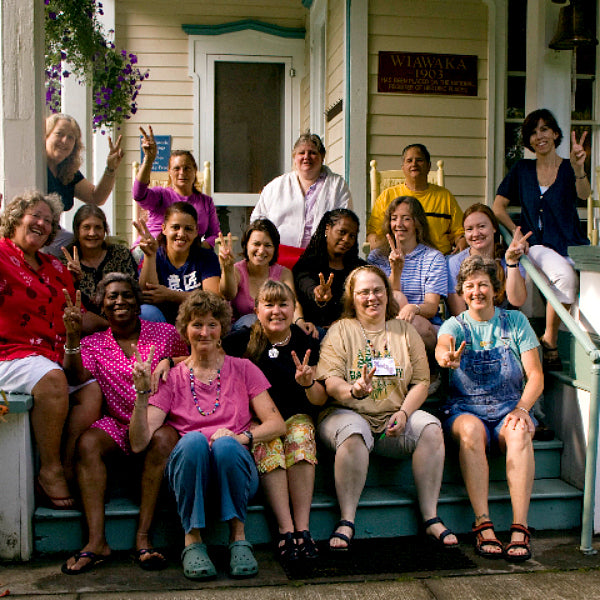Photo: Wiawaka
Remember the old saying, “A woman’s work is never done”? The day-to-day lives of working women have always been demanding and exhausting, especially since they have often returned home to even more work (none of it compensated), taking care of children, family, and more.
Historically, purposeful places for those hard-laboring women to get some R&R were rare. In New York, there is a special place that bridges the past and still delights the present with such a mission: the Wiawaka Center for Women, located at the southern end of Lake George in the foothills of the Adirondacks. Amazingly, it celebrates its 115th season in operation this year.
Founded in 1903 by Mary Wiltsie Fuller, the center was created as an affordable vacation retreat for women who worked in factories in cities like Troy and Cohoes and did not have the wherewithal to afford a period of rest and relaxation. Fuller, the daughter of a Troy industrialist, became aware of the hardworking women who toiled at local shirt-collar factories, mills, and laundries, often going years without time off.

Photo: Wiawaka
Fuller volunteered with the Girls Friendly Society of the Episcopal Church. Through that association and her well-connected circle of passionately politically progressive friends, including Katrina Trask, who founded the famed writer’s retreat called Yaddo in Saratoga Springs with her husband Spencer Trask, was able to elicit sponsorship and build the camp. Trask actually first leased, and then sold, the land to Fuller. A group of 50 friends were able to put together the funds to renovate and build out the existing structures for a full-fledged vacation camp for working women.
She could not have lucked into a better location, sprawled as it is in the midst of Adirondack Park at the base of French Mountain.
When it officially opened, Wiawaka could accommodate 38 women for a week at $3.50 a person. Room and board were included. Wiawaka was, and still is, operated as a nonprofit.

Photo: Wiawaka
Over the years, the camp has evolved somewhat, but it has never relinquished its mission to provide a place for women to get together and take a deep breath. And it has always been much more than the sum of its parts.
Thanks to Trask’s passion for artistic patronage and her influence on the camp, especially in the beginning, women have also been encouraged to pursue creative hobbies during their stays.
Georgia O’Keeffe rested at the lodge for a time, (literally) drawing inspiration from the lush lake landscape, a stark contrast to the desert vistas that eventually entranced her. Her works from her stay at Lake George are stunning, and, according to historians, were formative. Some of her earliest explorations of close-up flowers include her paintings from that time of poppies, canna lilies, and petunias. Her husband Alfred Stieglitz hailed from Lake George, which is how she landed there in the first place.
Female visitors (although Wiawaka has hosted plenty of events on the grounds that include men and children) from every walk of life flock to the peaceful, natural beauty of Wiawaka’s 60-acres. There are five buildings, including quant Victorian cottages and a vast Adirondack-style lodge. All together, Wiawaka is capable of housing up to 54 people. Rooms have one or two twin beds; bathrooms and common areas are shared. There are no televisions or phones in the rooms, as complete relaxation and deep contemplation are encouraged. (Don’t panic tech addicts: TVs exist in common areas, and personal computers and iPhones are permitted on-site, but, as the center’s focus is relaxation, there isn’t a business center or on-call tech team).

Photos: Wiawaka
The mood is joyfully inclusive. Guests gather for meals in the Victorian-style three-story Fuller House, named after the founder, and often walk the grounds together, which include gardens, trails, a labyrinth, and a lakeside dock.
Depending on when you go, you could learn to belly dance, or take some intensive yoga or pilates classes. Visitors can also indulge in a variety of arts and crafts workshops, including photography, watercolor, doll-making, and pencil drawing.
Wiawaka offers a variety of themed weeks. There’s the Jane Austen Society Retreat (June 23-24th) with Jane-ites descending to join scholars in what will surely be a thrillingly geeky deep dive into Persuasion. Then there’s the Art of Conscious Living Retreat (June 25-29th), billed as an “experiential five-day retreat in a small group” to “unplug, look within and uncover internal blocks” preventing participants from living their best, inspired life.

Photos: Wiawaka
Contemplation, sweat, intellectualism, creativity: check. But let’s face it, a true vacation is incomplete without some time getting pampered. The Wiawaka Spa offers massages aplenty, as well as classes in energy medicine and therapeutic reiki.
Rates are confidentially tiered, and range from $125-$185 per person, per night, depending on the day of the week and a person’s ability to pay. (Weekends rates can be higher). Three meals a day are included, and workshops and classes are additional. Day passes cost just $15 and include entrance into one class. A season’s pass costs $125 and gives visitors access to the property for the season (officially, June 23-August 30).
Wiawaka proudly represents itself as “the oldest and longest continuously operating retreat for women in America.” In 2011, the New York Senate named Fuller a “Woman of Distinction.” In 2010, Wiawaka was listed as one of the National Park Service’s Places Where Women Made History (one of 74 in New York and Massachusetts).

Many of the women who go to Wiawaka are return-visitors. That’s the thing about life. When you learn to to take a breath, reflect, rejuvenate — when you figure out how to thrive, instead of just survive — there’s no going back.
Shop for R&R-inspired, Made-in-New-York gifts to give YOURSELF!

Browse the collection > > >


Leave a comment